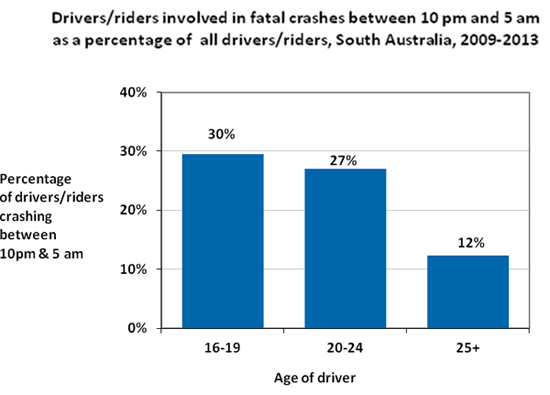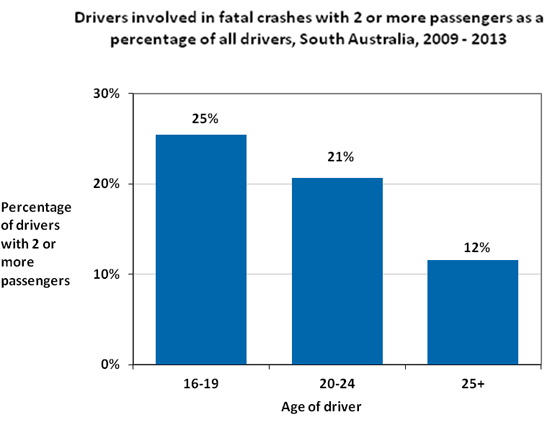
Applies to all P1 Licence holders and Learner motorcyclists.
THE RULE
No driving between midnight and 5am unless a qualified supervising driver is seated next to you or you meet the exemption criteria.
This rule does NOT apply to P2 drivers or motorcyclists under 25 who hold a P2 licence or a full car licence.

Applies to all P1 Licence holders under 25.
THE RULE
No more than one passenger aged 16-20 at any time of the day or night (immediate family members exempt), unless a qualified supervising driver is seated next to you or you meet the exemption criteria.
This rule does NOT apply to P2 drivers or motorcyclists under 25 who hold a P2 licence or a full car licence.

Applies to all Learner's Permit holders.
THE RULE
Before you apply for a P1 licence you will need to first pass the Hazard Perception Test (HPT).

Applies to all provisional licences.
THE RULE
The time you have to spend on a provisional licence is three years. One year on a P1; and two years on a P2 licence.
 No driving between midnight and 5am
No driving between midnight and 5amApplies to P1 licence holders and Learner motorcyclists under 25*.
This rule does NOT apply to P2 licence holders or motorcyclists under 25 who hold a P2 licence or a full car licence.
* exemptions apply.
Read more about no driving between midnight and 5am.
Who is a qualified supervising driver?
They could be your mum or dad or someone else that has held a full driver's licence for at least two years without disqualification. They must sit in the front passenger seat and meet drug and alcohol laws as if they are driving. E.g.: no drugs and no BAC of 0.05 or more.
Can I drive if I work night-shift?
Yes. You can drive between midnight and 5am to and from work by taking the shortest, most practicable route or in the course of doing your job.
Can I stop to get food or petrol on the way to or from work?
Yes, as long as you are taking the shortest, most practicable route between home and work.
All drivers have an increased risk of crashing when driving late at night but the risk is greater for young, inexperienced drivers. Inexperience in night driving as well as fatigue and risk taking are all contributing factors.
The figure below shows the drivers and riders involved in fatal crashes between 10 pm and 5 am as a percentage of all drivers and riders involved in fatal crashes in each age group before the rule was introduced.
As you can see, there was a very high percentage of younger drivers under 25.

Of the 16-19 year old drivers/riders involved in fatal crashes, 30% crashed between the hours of 10pm and 5am. This compared to 12% of drivers/riders involved in fatal crashes aged 25 or over.
No driving between midnight and 5am unless a qualified supervising driver is seated next to you or you meet the exemption criteria.
NOTE: You must take the shortest most practicable route between home and the activity.
Police and emergency service members are exempt from both night driving and passenger restrictions while on duty.
You do not need to apply for an exemption but you must be able to satisfy police that you meet the exemption criteria. Read more about exemptions.
What if there is an emergency?
If there's a medical emergency, call an ambulance. Driving another person to the hospital places you under greater pressure and may also put others in danger.
More FAQs
 No more than one passenger aged 16-20
No more than one passenger aged 16-20Applies to P1 Licence holders under the age of 25.
This rule does NOT apply to P2 drivers or motorcyclists under 25 who hold a P2 licence or a full car licence.
Who are immediate family members?
Your brother, sister, step-brother, step-sister, step-parent, guardian, step-grandparent, spouse, domestic partner, child or a person related to you according to Aboriginal or Torres Strait Islander kinship rules.
More FAQs
Can I drive my friends to school?
Yes, but only one friend aged between 16 and 20. In addition, you could take your brother and/or sister because immediate family members are exempt.
More FAQs
Who is a qualified supervising driver?
They could be your Mum or Dad or someone else that has held a full driver's licence for at least two years without disqualification. They must sit in the front passenger seat and meet drug and alcohol laws as if they are driving. E.g.: no drugs and no BAC of 0.05 or more.
More FAQs
Young drivers are four to five times more likely to be involved in a fatal crash when they have two or more similar aged passengers. Carrying passengers of a similar age can distract a young driver and encourage them to take greater risks.
The figure below shows the number of drivers involved in fatal crashes with 2 or more passengers in the vehicle as a percentage of all drivers involved in fatal crashes in each age group before the rule was introduced.
There was a very high percentage of younger drivers under 25.

Of the 16-19 year old drivers involved in fatal crashes, 25% were carrying two or more passengers at the time of the crash. This compared to 12% of drivers involved in fatal crashes aged 25 or over.
No more than one passenger aged 16-20 at any time of the day or night (immediate family members exempt), unless a qualified supervising driver is seated next to you or you meet the exemption criteria.
Requirement to carry passengers in the course of employment.
NOTE: Passenger restriction exemptions are Not available for any other activities, including education/training, volunteering, sports, artistic, charitable, religious or scientific activities.
Police and emergency service members are exempt from both night driving and passenger restrictions while on duty.
You do not need to apply for an exemption but you must be able to satisfy police that you meet the exemption criteria. Read more about exemptions.
For a list of current offences and penalties please click here.
You must not gain 4 or more demerit points during the provisional licence period.
 Hazard perception test for learners
Hazard perception test for learnersApplies to all Learner's Permit holders.
If you have a Learner's Permit and you are going to apply for a P1 licence, you will need to first pass the Hazard Perception Test.
The HPT is a computer-based test to assess the driver's ability to recognise dangerous situations and to react safely.
Click here for more information about the Hazard Perception Test including:
 Time on Your Ps
Time on Your PsThe time you need to spend on a provisional licence is three years. One year on a P1 and two years on a P2 licence.
The longer a provisional licence holder is subject to provisional licence conditions helps to keep young drivers out of high risk situations and is likely to result in fewer crashes. The minimum age at which a driver can obtain a full driver's licence is 20 years.